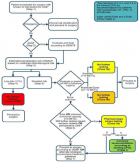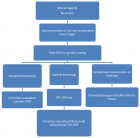Abstract
Short Communication
A comprehensive view of metallocycles in Pt(η3–P1X1P2)(Y), derivatives-structural aspects
Milan Melník* and Peter Mikuš
Published: 18 August, 2022 | Volume 6 - Issue 1 | Pages: 021-023
This review covers over one hundred Pt(II) complexes of the compositions Pt(η3–P1X1P2)(Y), (X1 = O1L, N1L, C1L, B1L, S1L or Si1L) and (Y = H, F, Cl, Br, I, O2L, N2L, C2L, or P3L). These complexes crystallized in five crystal classes: monoclinic (60 examples), triclinic (36 examples), orthorhombic (13 examples), trigonal (1 example) and tetragonal (1 example). Each heterotridentate organodiphosphine creates two metallocyclic rings with a common X1 atom. There are fourteen types of metallocycles from which the P1C2X1C2P2 is most common. The structural parameters (Pt-L, L-Pt-L) are analyzed and discussed with attention to the distortion of a square-planar geometry about the Pt(II) atoms as well as of trans-influence.
Read Full Article HTML DOI: 10.29328/journal.apps.1001032 Cite this Article Read Full Article PDF
Keywords:
Structure; Heterotridentate; Organodiphosphines; Pt(η3–P1X1P2)(Y); Trans-Influence
References
- Melník M, Mikuš P. Organomonophosphines in PtP2Cl2 derivatives structural aspects. Rev. Inorg. Chem. 2015; 22:179-189 https://doi.org/10.1515/revic-2020-0004
- Melník M, Mikuš P. Organodiphosphines in PtP2X2 (X = As, Ge or Te)
derivatives – Structural aspects. Main Group Met. Chem. 2020; 43:132–137 https://doi.org/10.1515/mgmc-2020-0016 - Melník M, Mikuš P. Heterotridentate organodiphosphines in Pt(η3–P1X1P2)(Y) derivatives-structural aspects. Inorg. Chem. 2021; aop https://doi.org/10.1515/revic-2021-0011
- Melník M, Mikuš P, Heterotridentate organodiphosphines in Pt(η3–P1C1P2)(X), (X = H, OL, NL, CL, F, Cl, Br or I) and Pt(η3–P1P2C1)(Cl) derivatives-structural aspects. Main Group Met. Chem., in press 2021.0044
- Melník M, Mikuš P, Heterotridentate organodiphosphines in Pt(η3–P1X1P2)(Y) (X1 = B, S, or Si) and Pt(η3–P1P2Si1)(Y) derivatives-structural aspects. Rev. Inorg. Chem., in press 2021.0028.R1
- Yang L, Powell DR, Houser RP. Structural variation in copper(I) complexes with pyridylmethylamide ligands: structural analysis with a new four-coordinate geometry index, tau4. Dalton Trans. 2007 Mar 7;(9):955-64. doi: 10.1039/b617136b. Epub 2007 Jan 29. PMID: 17308676.
Figures:
Similar Articles
-
The association between hypoxia, chronic ischemia and alters prostate structure and progress of chronic prostatic diseaseMauro Luisetto*,Behzad Nili Ahmadabadi,Ghulam Rasool Mashori,Gamal Abdul Hamid. The association between hypoxia, chronic ischemia and alters prostate structure and progress of chronic prostatic disease. . 2019 doi: 10.29328/journal.apps.1001016; 3: 042-078
-
Revisiting carotenoid aggregates discerning non-covalent interaction of unbranched fatty acid analoguesMiklós Simonyi*. Revisiting carotenoid aggregates discerning non-covalent interaction of unbranched fatty acid analogues. . 2022 doi: 10.29328/journal.apps.1001028; 6: 001-005
-
A comprehensive view of metallocycles in Pt(η3–P1X1P2)(Y), derivatives-structural aspectsMilan Melník*,Peter Mikuš. A comprehensive view of metallocycles in Pt(η3–P1X1P2)(Y), derivatives-structural aspects. . 2022 doi: 10.29328/journal.apps.1001032; 6: 021-023
-
Acyclovir Induced Acute Kidney Injury: A Case ReportZiauddin Mohammed*, Mariya Zoha Muskan, Megha Mohan Narayanan. Acyclovir Induced Acute Kidney Injury: A Case Report. . 2024 doi: 10.29328/journal.apps.1001048; 8: 001-002
-
Beta-1 Receptor (β1) in the Heart Specific Indicate to StereoselectivityRezk Rezk Ayyad*, Ahmed Mohamed Mansour, Ahmed Mohamed Nejm, Yasser Abdel Allem Hassan, Norhan Hassan Gabr, Ahmed Rezk Ayyad. Beta-1 Receptor (β1) in the Heart Specific Indicate to Stereoselectivity. . 2024 doi: 10.29328/journal.apps.1001060; 8: 082-088
Recently Viewed
-
Non-surgical Treatment of Verrucous Hyperplasia on Amputation Stump: A Case Report and Literature ReviewSajeda Alnabelsi*, Reem Hasan, Hussein Abdallah, Suzan Qattini. Non-surgical Treatment of Verrucous Hyperplasia on Amputation Stump: A Case Report and Literature Review. Ann Dermatol Res. 2024: doi: 10.29328/journal.adr.1001034; 8: 015-017
-
Outpatient operative hysteroscopy: evaluation of patient satisfaction and acceptanceClare Margaret Crowley*,Noelle Gill,Minna Geisler. Outpatient operative hysteroscopy: evaluation of patient satisfaction and acceptance. Clin J Obstet Gynecol. 2022: doi: 10.29328/journal.cjog.1001098; 5: 005-008
-
Predictors of positive treatment response to PTNS in women with overactive bladderSuneetha Rachaneni*,Doyo Enki,Megan Welstand,Thomasin Heggie,Anupreet Dua. Predictors of positive treatment response to PTNS in women with overactive bladder. Clin J Obstet Gynecol. 2022: doi: 10.29328/journal.cjog.1001097; 5: 001-004
-
Prediction of neonatal and maternal index based on development and population indicators: a global ecological studySedigheh Abdollahpour,Hamid Heidarian Miri,Talat Khadivzadeh*. Prediction of neonatal and maternal index based on development and population indicators: a global ecological study. Clin J Obstet Gynecol. 2021: doi: 10.29328/journal.cjog.1001096; 4: 101-105
-
A Genetic study in assisted reproduction and the risk of congenital anomaliesKaparelioti Chrysoula,Koniari Eleni*,Efthymiou Vasiliki,Loutradis Dimitrios,Chrousos George,Fryssira Eleni. A Genetic study in assisted reproduction and the risk of congenital anomalies. Clin J Obstet Gynecol. 2021: doi: 10.29328/journal.cjog.1001095; 4: 096-100
Most Viewed
-
Evaluation of Biostimulants Based on Recovered Protein Hydrolysates from Animal By-products as Plant Growth EnhancersH Pérez-Aguilar*, M Lacruz-Asaro, F Arán-Ais. Evaluation of Biostimulants Based on Recovered Protein Hydrolysates from Animal By-products as Plant Growth Enhancers. J Plant Sci Phytopathol. 2023 doi: 10.29328/journal.jpsp.1001104; 7: 042-047
-
Sinonasal Myxoma Extending into the Orbit in a 4-Year Old: A Case PresentationJulian A Purrinos*, Ramzi Younis. Sinonasal Myxoma Extending into the Orbit in a 4-Year Old: A Case Presentation. Arch Case Rep. 2024 doi: 10.29328/journal.acr.1001099; 8: 075-077
-
Feasibility study of magnetic sensing for detecting single-neuron action potentialsDenis Tonini,Kai Wu,Renata Saha,Jian-Ping Wang*. Feasibility study of magnetic sensing for detecting single-neuron action potentials. Ann Biomed Sci Eng. 2022 doi: 10.29328/journal.abse.1001018; 6: 019-029
-
Pediatric Dysgerminoma: Unveiling a Rare Ovarian TumorFaten Limaiem*, Khalil Saffar, Ahmed Halouani. Pediatric Dysgerminoma: Unveiling a Rare Ovarian Tumor. Arch Case Rep. 2024 doi: 10.29328/journal.acr.1001087; 8: 010-013
-
Physical activity can change the physiological and psychological circumstances during COVID-19 pandemic: A narrative reviewKhashayar Maroufi*. Physical activity can change the physiological and psychological circumstances during COVID-19 pandemic: A narrative review. J Sports Med Ther. 2021 doi: 10.29328/journal.jsmt.1001051; 6: 001-007

HSPI: We're glad you're here. Please click "create a new Query" if you are a new visitor to our website and need further information from us.
If you are already a member of our network and need to keep track of any developments regarding a question you have already submitted, click "take me to my Query."


















































































































































